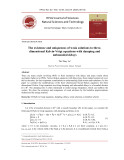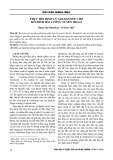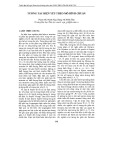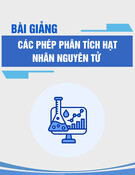
* Corresponding author.
E-mail address: khodabakhshi2002@gmail.com (M. R. Khodabakhshi)
© 2020 by the authors; licensee Growing Science, Canada
doi: 10.5267/j.ccl.2019.006.004
Current Chemistry Letters 9 (2020) 9–18
Contents lists available at GrowingScience
Current Chemistry Letters
homepage: www.GrowingScience.com
2-(Aminomethyl)benzimidazole/Cu2+ immobilized on Fe3O4@SiO2: a convenient
magnetic nanocatalyst for click reaction of aryl iodide/benzyl halide, sodium azide
and terminal alkyne
Mostafa Mehdipoura and Mohammad Reza Khodabakhshia*
aApplied Biotechnology Research Center, Baqiyatallah University of Medical Sciences, Vanak Square, Mollasadra Ave. P.O. Box:
1435915371, Tehran, Iran
C H R O N I C L E A B S T R A C T
Article history:
Received May 29, 2019
Received in revised form
June 11, 2019
Accepted June 16, 2019
Available online
June
1
6
,
201
9
In this work, the Fe3O4@SiO2@AMBI/Cu nanocatalyst was synthesized and used as a well-
organized magnetic nanocatalyst for the click reaction. This nanocatalyst has effectively
catalyzed the cyclization of terminal alkynes and sodium azide with aryl iodide/benzyl halide
for the formation of 1,4-disubstituted 1,2,3-triazoles under mild reaction conditions with good
to high yields in low reaction time.
© 2020 by the authors; licensee Growing Science, Canada
.
Keywords:
Click reaction
Copper
2-(Aminomethyl)benzimidazole
dihydrochloride
Fe3O4@SiO2
1,4-disubstituted 1,2,3-triazoles
1. Introduction
The term bioorthogonal chemistry was born in 2003 by Bertozzi1. Bioorthogonal chemistry is about
designing reactions that can be achieved in a biological environment and proceeded in living systems.
This kind of reactions are posing great biocompatibility and selectivity, also opening new approaches
for new innovations in biology by feasible various bond formations in biological systems. From this
kind of reactions, click reaction should be mentioned. This reaction was defined in 2001 by Sharpless
as an insensitive and easy performing reaction by accessible reagents.2-3 In this reaction, triazoles can
be synthesized by the reaction of azide and terminal amide and in the presence of Cu as the catalyst.
Click chemistry is one of the newest and most operative tools for the synthesis of drug-like heterocyclic
compounds with carbon-heteroatom-carbon (C−X−C) bonds that can accelerate the drug discovery
improvement and lead to synthesis of biological compounds with anti-HIV, antiviral, antibiotic and
antibacterial activities. 4-10 Until today, many articles have reported click chemistry by various Cu-
catalyzed procedures, but due to its importance, it is necessary to develop new methodologies.

10
History of using metal catalysis for heterogeneous catalysis is going back to 60 years ago.11-13 In
heterogeneous catalysis, phase of the catalyst, reactant, and product are different. Thus, the catalyst can
be separated from the reaction media more easily compared to homogeneous catalysis. Using transition
metals in heterogeneous catalysis, due to their properties, is becoming more and more common during
time. Among transition metals, Cu, as an economic and environmentally fried metal, could be a reliable
choice for synthesizing an efficient catalyst. Some of the reported applications of Cu are as followed:
selective CO bond cleavage of glycerol 14, reduction of CO2 electrochemically, 15 catalytic
dehydrogenation, catalytic NO reduction 16, and CH activation .17
In metal catalysis, among various variables that affect the catalytic behavior of the catalyst, the size
of the particles, the shape of the particles, the nature of the selected support for immobilizing metal
particles on it, and also the nature of other metals present in the structure of the catalyst could be named.
According to the influence of the size in the efficiency of the catalyst, synthesizing nanoparticles could
be highly beneficial due to their high surface area. As a result, among this explosion of research in the
field of nanocatalysis for various reactions such as reduction, oxidation, hydrogenation,
electrocatalytic, organic reactions, and photocatalytic reaction, synthesizing metal nanocatalysts with
promised properties is even a huge challenge.18
Herein, to improve previous researches and to prepare effective heterogeneous catalysts to proceed
click reaction, the Fe3O4@SiO2@AMBI/Cu nanocatalyst was synthesized using FeCl3.6H2O,
FeCl2.4H2O, NH4OH, tetraethyl orthosilicate (TEOS), 2-(aminomethyl) benzimidazole
dihydrochloride (AMBI), and Cu(OAc)2, and used as an efficient magnetic nanocatalyst (Scheme 1).
This nanocatalyst has effectively catalyzed the synthesis of 1,4-disubstituted-1,2,3-triazoles using
terminal aryl alkynes, sodium azide and aryl iodide/benzyl halide with good to high yields in low
reaction time (Scheme 1). The most challenging subject of this procedure was the performing of the
coupling reaction using Cu-catalyst. This process was carried out successfully in the presence of L-
proline with quiet satisfactory results.
Scheme 1. Click reactions using Fe3O4@SiO2@AMBI/Cu nanocatalyst

M. Mehdipour and M. R. Khodabakhshi / Current Chemistry Letters 9 (2020)
11
2. Results and Discussion
FT-IR spectra of Fe3O4, Fe3O4@SiO2, and Fe3O4@SiO2@AMBI/Cu are illustrated in Figure 1. As
illustrated in Figure 1, functional groups of Fe3O4, Fe3O4@SiO2, and Fe3O4@SiO2@AMBI/Cu can be
seen in FT-IR spectra. In the FT-IR spectra of Fe3O4, a broad peak at around 500-600 cm-1 is attributed
to the Fe-O group. In Fe3O4@SiO2 spectra, in addition to the Fe-O peak, a broad peak at 1050-1250
cm-1 is related to the presence of the Si-O group. Also, in the Fe3O4@SiO2@AMBI/Cu spectra, in
addition to all of the abovementioned peaks, a C=C stretching peak and a characterization peak of N-
H are observed at 1649 cm-1 and 3400 cm-1, respectively.
Fig. 1. FT-IR spectra of a) Fe3O4, b) Fe3O4@SiO2, and c) Fe3O4@SiO2@AMBI/Cu
The morphology and size of synthesized Fe3O4@SiO2@AMBI/Cu were studied by SEM and TEM
images and they are shown in Figure 2. Consequently, nanoparticles were homogenously dispersed on
Fe3O4 as a core with an average diameter of about 20 nm. These analyses revealed that there is no
roughness and aggregation present in the surface of Fe3O4@SiO2@AMBI/Cu.
Fig. 2. SEM and TEM spectra of Fe3O4@SiO2@AMBI/Cu
0
10
20
30
40
50
60
70
80
90
100
5001000150020002500300035004000
Transmittance (%)
Wavenumber (cm-1)
Fe3O4 Fe3O4@SiO2 Fe3O4@SiO2@AMBI/Cu

12
The purity and crystalline structure of the synthesized Fe
3
O
4
@SiO
2
@AMBI/Cu were studied using
X-ray diffractions. The XRD pattern of the powders of the final nanocatalyst is indicated in Figure 3.
Corresponding peaks of Fe
3
O
4
in XRD were observed at 2θ=30.0, 35.0, 42.0, 52.0, 56.0, and 62.0,
which are similar to the pattern of the reported Fe
3
O
4
nanoparticles before.
19, 30
Fig. 3. XRD pattern of Fe
3
O
4
@SiO
2
@AMBI/Cu
EDX analysis was performed to study the elemental compositions of Fe
3
O
4
@SiO
2
@AMBI/Cu. The
EDX spectrum of Fe
3
O
4
@SiO
2
@AMBI/Cu is presented in Figure 4. In this spectrum, the existence of
Fe and O has proved the synthesis of Fe
3
O
4
. In addition, EDX shows the presence of Cu, N, and Si
which proved the successful synthesis of Fe
3
O
4
@SiO
2
@AMBI/Cu.
Fig. 4. EDX spectrum of Fe
3
O
4
@SiO
2
@AMBI/Cu Fig. 5. TGA curve of Fe
3
O
4
@SiO
2
@AMBI/Cu
The TGA analysis of the synthesized Fe
3
O
4
@SiO
2
@AMBI/Cu was taken to understand the stability
of it (Figure 5). In TGA, the weight loss under 200
o
C is related to volatile compounds and the weight
loss at about 500
o
C is related to decomposition of ligand. Furthermore, due to the existence of Cu and
Fe
3
O
4
, it did not decompose completely at temperatures above 800
o
C.
2.3 Catalytic activity of Fe
3
O
4
@SiO
2
@AMBI/Cu nanocatalyst
Most of the click reactions which started with aryl iodide need long reaction times and hard
conditions. Therefore, we decided to develop this kind of reactions with a new and efficient protocol
to proceed this reaction under mild conditions. Initial studies including the optimization of the type of
the catalyst, the amount of the catalyst, the reaction time, the reaction temperature, and the type of the
base and the solvent were conducted using iodobenzene, phenyl acetylene and sodium azide as the
model reaction.
First of all, to understand the best catalyst, various catalysts including CuCl, CuI, Cu
2
O, and
Fe
3
O
4
@SiO
2
@AMBI/Cu were used. In comparison to other catalytic systems, the best yield was gained
using the Fe
3
O
4
@SiO
2
@AMBI/Cu nanocatalyst. In the next step, in order to optimize the amount of
the catalyst, three different amounts of catalysts, including 10, 20, and 30 mg of
Fe
3
O
4
@SiO
2
@AMBI/Cu catalyst were used, in which by using 30 mg of catalyst, 96% yield was
obtained. For the acquisition of the best temperature of the reaction, after carrying out the reaction in

M. Mehdipour and M. R. Khodabakhshi / Current Chemistry Letters 9 (2020)
13
different temperatures, it was concluded that the optimizied temperature is 100oC. Afterwards, different
ligands were used (L-proline, picolinic acid, DMEDA, phenantroline, and bipyridine) to carry out
coupling reactions of aryl iodide. From the results, it could be concluded that in the presence of L-
proline, higher yield of the product was gained. In order to select the best base, NaOH, K2CO3, Cs2CO3,
NaHCO3, and K2PO4 were used and as the result, in the presence of NaOH, the best result was gained.
Finally, for the selection of the best solvent, the performance of several solvents was evaluated. In
comparison to toluene, dioxane, and EtOH as a solvent, using the combination of H2O/DMSO yielded
to the best results for this reaction (Table 1). By this optimized condition, various derivatives were
synthesized (Scheme 2).
Table 1. Optimizing different parameters in the model reaction
a Isolated yield
Almost all of the abovementioned optimizing reactions were studied in the reaction of benzyl bromide,
phenyl acetylene, and sodium azide as the model reaction.. In this case, the best result was gained using
H2O as the solvent and at 90oC (entry 5, Table 2). Also, different derivatives 1,4-disubstituted 1,2,3-
triazoles using benzyl bromide/chloride, aryl alkyne and sodium azide were synthesized by this
condition (Scheme 3).
Table 2. Optimizing different parameters in the click reaction of benzyl bromide and phenyl
acetylenea
Yield[%]
[a]
Solvent
Time(h)
T(
˚C)
Cat [%]
Catalyst
Enter
-
H
2
O
7
50
-
-
1
21
H
2
O
8
90
-
-
2
76
H
2
O
8
90
10
Fe
3
O
4
@SiO
2
@AMBI/Cu
3
87
H
2
O
8
90
20
Fe
3
O
4
@SiO
2
@AMBI/Cu
4
98
H
2
O
0.4
90
30
Fe
3
O
4
@SiO
2
@AMBI/Cu
5
98
H
2
O
0.4
90
40
Fe
3
O
4
@SiO
2
@AMBI/Cu
6
51
H
2
O
1
r.t
30
Fe
3
O
4
@SiO
2
@AMBI/Cu
7
81
H
2
O
8
r.t
30
Fe
3
O
4
@SiO
2
@AMBI/Cu
8
15
Toluene
2
90
30
Fe
3
O
4
@SiO
2
@AMBI/Cu
9
65
CH
3
OH
2
Reflux
30
Fe
3
O
4
@SiO
2
@AMBI/Cu
10
38
CH
3
CN
2
Reflux
30
Fe
3
O
4
@SiO
2
@AMBI/Cu
11
83
EtOH/H
2
O
1
Reflux
30
Fe
3
O
4
@SiO
2
@AMBI/Cu
12
95
H
2
O
12
Reflux
30
Cu/SiO
2
13
94
CH
2
Cl
2
12
Reflux
30
Chitosan
-
coated Fe
3
O
4
/Cu
14
98
H
2
O
4
90
30
Chitosan/Cu
15
a Isolated yield
Yield[%][a] Solvent Time(h) T(˚C) Base Ligand Cat
[%]
Catalyst Enter
trace
DMSO/H
2
O
12
100
NaOH
L
-
proline
-
-
1
45
DMSO/H
2
O
12
100
NaOH
L
-
proline
20
CuCl
2
50
DMSO/H
2
O
12
100
NaOH
L
-
proline
20
CuI
3
40
DMSO/H
2
O
12
100
NaOH
L
-
proline
20
Cu
2
O
4
73
DMSO/H
2
O
2
100
NaOH
L
-
proline
10
Fe
3
O
4
@SiO
2
@AMBI/Cu
5
84
DMSO/H
2
O
2
100
NaOH
L
-
proline
20
Fe
3
O
4
@SiO
2
@AMBI/Cu
6
96
DMSO/H
2
O
2
100
NaOH
L
-
proline
30
Fe
3
O
4
@SiO
2
@AMBI/Cu
7
trace
DMSO/H
2
O
12
100
NaOH
picolinic acid
30
Fe
3
O
4
@SiO
2
@AMBI/Cu
8
trace
DMSO/H
2
O
12
100
NaOH
DMEDA
30
Fe
3
O
4
@SiO
2
@AMBI/Cu
9
trace
DMSO/H
2
O
12
100
NaOH
2,2´
-
bipyridine
30
Fe
3
O
4
@SiO
2
@AMBI/Cu
10
trace
DMSO/H
2
O
12
100
NaOH
1,10
-
phenanthroline
30
Fe
3
O
4
@SiO
2
@AMBI/Cu
11
53
DMSO/H
2
O
8
100
K
2
CO
3
L
-
proline
30
Fe
3
O
4
@SiO
2
@AMBI/Cu
12
63
DMSO/H
2
O
8
100
Cs
2
CO
3
L
-
proline
30
Fe
3
O
4
@SiO
2
@AMBI/Cu
13
54
DMSO/H
2
O
8
100
NaHCO
3
L
-
proline
30
Fe
3
O
4
@SiO
2
@AMBI/Cu
14
40
DMSO/H
2
O
8
100
K
2
PO
4
L
-
proline
30
Fe
3
O
4
@SiO
2
@AMBI/Cu
15
71
DMSO
8
100
NaOH
L
-
proline
30
Fe
3
O
4
@SiO
2
@AMBI/Cu
16
77
H
2
O
8
90
NaOH
L
-
proline
30
Fe
3
O
4
@SiO
2
@AMBI/Cu
17
23
Toluene
8
90
NaOH
L
-
proline
30
Fe
3
O
4
@SiO
2
@AMBI/Cu
18
32
Dioxane
8
90
NaOH
L
-
proline
30
Fe
3
O
4
@SiO
2
@AMBI/Cu
19
61
EtOH
8
80
NaOH
L
-
proline
30
Fe
3
O
4
@SiO
2
@AMBI/Cu
20
63 DMSO/H2O 4 r.t NaOH L-proline 30 Fe3O4@SiO2@AMBI/Cu 21




















![Bộ câu hỏi lý thuyết Vật lý đại cương 2 [chuẩn nhất/mới nhất]](https://cdn.tailieu.vn/images/document/thumbnail/2025/20251003/kimphuong1001/135x160/74511759476041.jpg)
![Bài giảng Vật lý đại cương Chương 4 Học viện Kỹ thuật mật mã [Chuẩn SEO]](https://cdn.tailieu.vn/images/document/thumbnail/2025/20250925/kimphuong1001/135x160/46461758790667.jpg)




